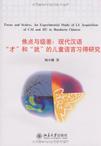焦点与级差
2009-4
北京大学出版社
杨小璐
284
267000
无
杨小璐是我在香港中文大学英文系从事教研工作期间(1987-1998年)所指导的、专攻一语研究的第一位博士生。①她的博士论文从语言学理论角度,在形式语义学的基础上,通过五种不同的实验手段,研究4至8岁普通话儿童对“才”和“就”的理解和使用,从而了解级差词语和限制焦点的认知结构。作为级差词语,“才”和“就”跟句法语义界面有密切的关系,跨越数量、时间和条件假设三个认知领域,涉及说话者的预期和实际情况之间的级差关系。例如,句(1a)的“才”标记着,在时间轴上,“他三点来”这个事件比说话者预期的晚;(1b)的“就”则标记事件的发生比预期早。句(2a)和(2b)反映这两个级差词在数量轴上的对立:前者表示,实际数量比说话者预期量多,而后者则表示实际量少于预期量。在表示条件假设方面,“才”表达必要条件,而“就”则表达充分条件。句(3a)表示,放红色球是天平秤翘起来的必要条件,若放别的球,天平秤一定不会翘起来;句(3b)则表示,如果放红色球,天平秤必定翘起;但如不放红色球,天平秤也一样有可能翘起。
儿童的语义习得近年来一直是语言学、心理语言学等学科研究的热门领域,也是语言与认知研究的热点。本书从理论语言学的角度出发,结合当代心理语言学的实验研究方法,严格按照国际主流儿童语言习得研究的实验程序和理论假设对汉语儿童焦点敏感词“才”/“就”与焦点、级差表征有关的句法和语义知识进行了多方面的考察,揭示了汉语儿童认知发展与焦点、级差结构表征之间的内在关系,探讨了生成语法规则、语言环境、认知在语义习得中的作用。作者从级差语义发展与认知、语义与语用发展交互作用的角度对实验结果做了有说服力的解释。从谓语焦点结构与自然语言中信息表达的非标记性结构(即主题一述语结构)的同构性以及英汉句子结构的差异方面探讨了汉语儿童与英语儿童对限制焦点理解的异同,对语言的共性和个性与语言习得之间的关系做了积极的理论探讨。
杨小璐,清华大学外语系副教授,清华大学心理学与认知科学中心兼职研究人员。香港中文大学现代语言与文化系语言学博士,美国麻省理工大学脑与认知科学系访问学者(2005年)。研究方向是语言习得、心理语言学以及语言与认知。目前关注的是儿童句法、语义发展,希望透过儿童的
Chapter One Introduction 1.1 Focus and Scales. Only and Even 1.2 CAI and JIU in Mandarin Chinese 1.3 Significance of the Present Study 1.4 Overview of the BookChapter Two Semantics and Pragmatics of CAI and JIU 2.1 Introduction 2.2 CAI and JIU as Scalar Focus Particles 2.3 CAI and JIU in the Time Domain 2.4 CAI and JIU in the Quantity Domain 2.5 CAI and JIU in the Conditional Domain 2.6 CAI and JIU as Restrictive Focus Operators 2.6.1 A distinction between pre-foci and post-loci CAI and JIU 2.6.2 Restrictive CAI/JIU. and ZHI 2.6.2.1 Restrictive focus operator ZHI in Mandarin Chinese 2.6.2.2 CAI and JIU as restrictive focus operators 2.7 SummaryChapter Three Investigating CAI and JIU in Acquisition: Rationale and Research Hypotheses 3.1 Time/Quantity CAI/JIU and Scales in Acquisition 3.2 Time, Quantity, and Conditional CAI/JIU Acquisition 3.3 Restrictive Focus in Acquisition 3.4 A Preliminary Survey of CAI and JIU in Children's Natural Speech Chapter Four The Acquisition of CAI/JIU. Experiments (I) 4.1 Elicited Imitation Study. Children's Understanding of CAI/JIU Co-occurrence Restrictions 4.1.1 Method 4.1.1.1 Subjects 4.1.1.2 Test design 4.1.1.3 Procedure 4.1.2 Results 4.1.2.1 Analysis of correct imitation 4.1.2.1.1 Overall accuracy 4.1.2.1.2 Effects of sentence type 4.1.2.1.3 Effects of domain on FCR items 4.1.2.2 Analysis of incorrect imitation 4.1.2.2.1 Overview of changes 4. 1.2.2.2 Changes made with VCR and TRI items 4.1.2.2.3 Changes made with VCR and TRI items by domain 4.1.2. 2. 4 Deletion errors by domain 4.1.3 Discussion 4.2 Sentence Selection Study: Children's Understanding of CAI/JIU in Context 4.2.1 Method ……Chapter Five The Acquistion of Restrictive Focus: ExperimentsChapter Six General Discussion and ConclusionBibliographyAppendices后记
Recall the scalar differences between CAI and JIU. For CAI,the asserted element is always located farther up on the scale than the expeeted element, hence the later-than-expected or morethan-expected implictures. For JIU, the asserted element is always located farther down on the scale than the expected element,thus generating the earlier-than-expected or less-than-expected implicatures. Following this characterization, it seems that CAI evokes scales directed upward and JIU evokes scales directed downward.The asserted element highlighted by CAI is evaluated as higher than the speakers expectation, whereas the asserted element marked by JIU is evaluated as lower than the speakers expectation.However,this is not an accurate cognitive model of the CAI/JIU scales. From a cognitive view of CAI/JIU, it is the asserted element that serves as the point of reference rather than the expected element.An example helps us to understand this point. When uttering sentences like (3), the speaker not only tells the hearer that Lisi came at three oclock but also conveys by using CAI and JIU his evaluation of whether Lisi came late or early as compared to his expectation.

无
这个书是纯英文的,其实翻译过来就知道内容比较好!
还没看,先不评论